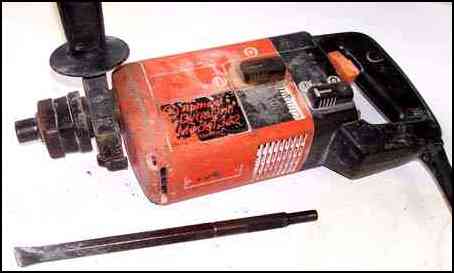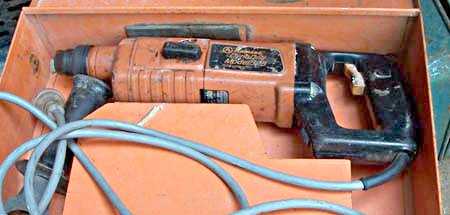 |
|||||||||
Medium Sized Hammer Drill, Masonry Drill and Chipping Hammer
First off, Ramset is a company that makes and sells a wide variety of fixings. Explosive charges and nails, expanding bolts etc. They don't as far as I know make power tools. This is made by Bosch and re badged. So if you are looking for a good Hammer drill, look for Bosch. These are dedicated, masonry only drills. They have the gearbox in an oil bath for longer life. These are both Ramset Dyna Drills, but manufacturers have similar tools. They have an internal clutch to save the drill and yourself from damage when they jam. As they often do. If one jams solid, take the machine off the drill bit and wind it back out of the hole with a "Stillson" type wrench. The larger one is almost identical to a Bosch that I had once, so I guess that they are Bosch tools re badged for Ramset. I guess it's towards the middle of the masonry drill field. I use it for drilling say 12mm to 25mm dia. holes. For smaller holes the top one is more convenient and lighter. If you only have small holes up to say 8mm, a medium sized ordinary drill with the hammer function does a reasonable job. I have never had to drill larger holes than 25mm in residential construction, but a couple of times I've had to drill long holes through concrete beams, and it has been cheaper to hire a larger drill with the long bits included, than to buy a new long bit. (They're a bit pricey :-) The larger one is typical of this type of tool. This has been and still is an incredible workhorse. Very rarely has it been in for service in the 20+ years that I have had it. Considering the environment it works in, dust, dust and more dust, it's incredible. Just good engineering with the hard working parts in an oil bath. Chasing walls and floors, chipping out small bits of concrete is easy. Change to a chisel bit and turn the lever to stop the drilling action and this thing will chase grooves in walls all day. It has a fast hammering action. I usually sharpen to chisels myself heaps of times before throwing them away. The re sharpen is never as good a the original, but it is a lot cheaper. Just copy the same angles as original. Keep it cool when grinding, using plenty of water. If you don't have a bench grinder, use an angle grinder. Slowly, slowly, plenty of water, it is easy to overheat the steel. You can tell you have done that when the tip turns blue. I found the drill bits quite expensive, so after a while I bought an adapter to use the cheaper taper shank Kango style bits. (They last just as long.) Check out the cost of spare bits etc. because you will use a lot if you are working it hard. The 342 like the rest of it's kind, has a clutch in it so that if it is in a jamming situation the motor is saved from damage. You usually get a bit of warning and can free the drill bit, but quite often it gets stuck and you have to back the drill bit out of the hole with vise grips or a Stillson type wrench. (There's no reverse). The usual reason for it jamming of course is hitting reo steel. A fact of life with the work that they do. I've got a green grit stone in my bench grinder that I can use for sharpening the tungsten tips, but rarely use it on the bits this size. Before they stop drilling efficiently they wear in other ways. After a while a 16mm bit will end up only drilling say a 15mm hole. This is no good for fixing expanding bolts that require an accurate hole. So it's time for a new bit. Don't throw the old one away, as it can still be used for drilling holes for Chemset bolts or epoxying starter bars in concrete that don't need an exact hole size.
The other way that they wear, and this is usually the reason you buy another bit, is on the screw flutes that carry the dust to the surface and out of the hole . These wear away behind the drill tip (see picture), and if you are drilling down into a slab the dust packs up behind the drill head and jams the bit. When they are worn like this you have to just keep lifting the drill up and down out of the hole while it's still spinning to clear the dust. A real pain, which eventually means buying a new bit, even though the working part, the tip is still functional. When hammer drilling sideways into walls the dust clears a lot easier and you don't get the same problem. Not found it yet? Try this FAST SITE SEARCH or the whole web |
Hire Equipment  Furniture Fittings - Architectural Hardware - Electronic Locking Systems - Technical Hardware BuilderBill sponsorship Power tool related pages
|
||||||||
|
|
|||||||||
|
Please Note! The information on this site is offered as a guide only! When we are talking about areas where building regulations or safety regulations could exist,the information here could be wrong for your area. It could be out of date! Regulations breed faster than rabbits! You must check your own local conditions. Copyright © Bill Bradley 2007-2012. All rights reserved. |
|||||||||


